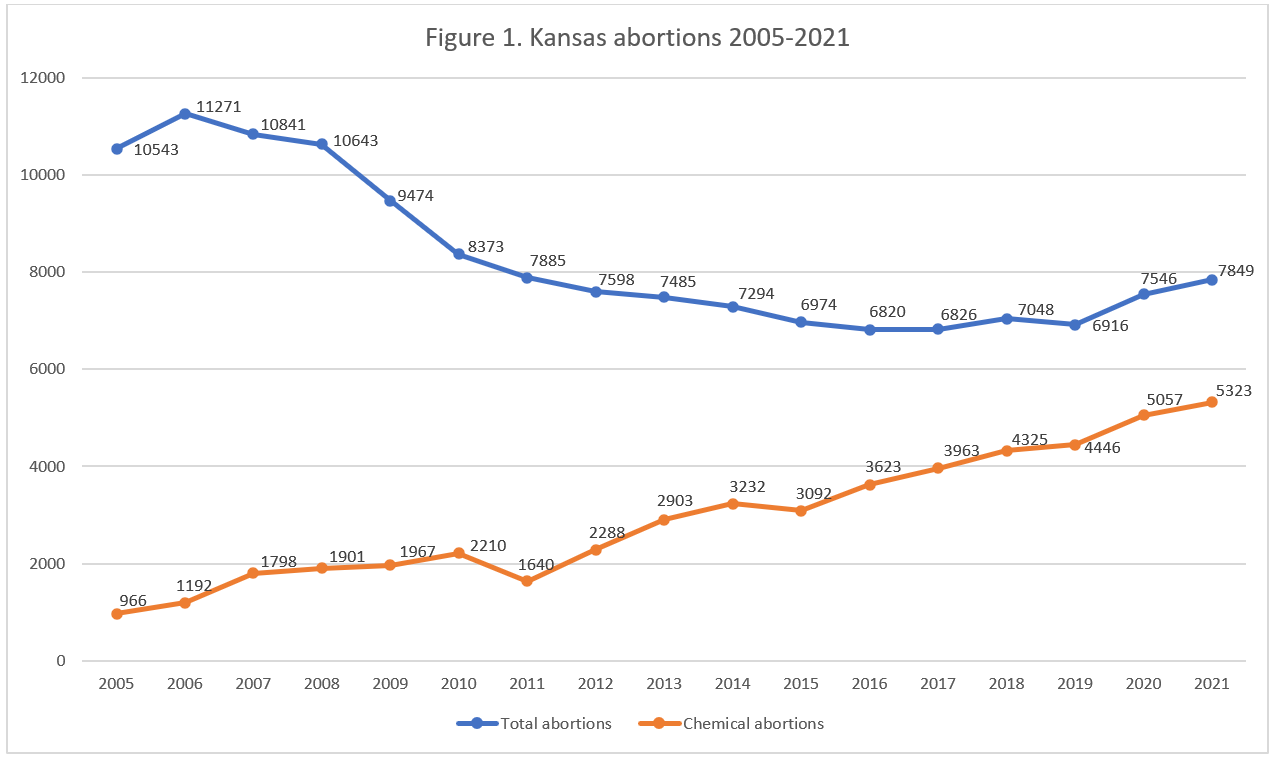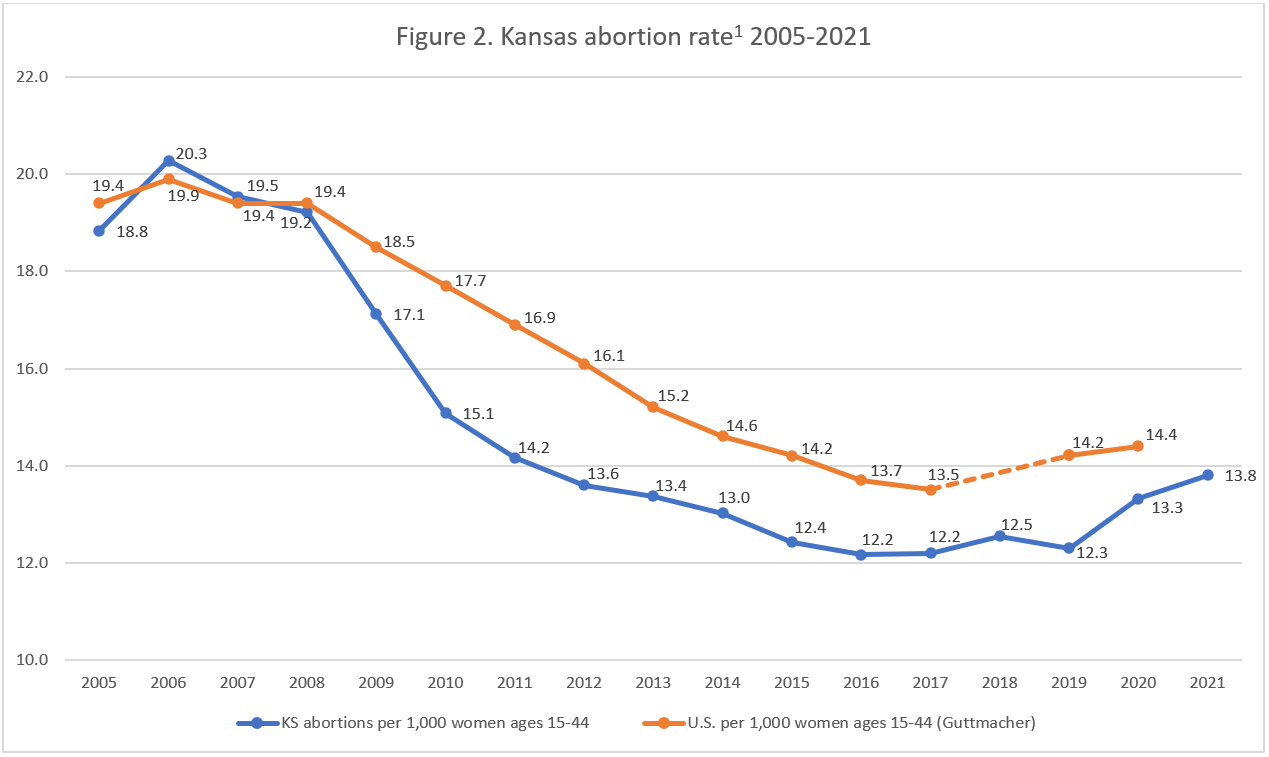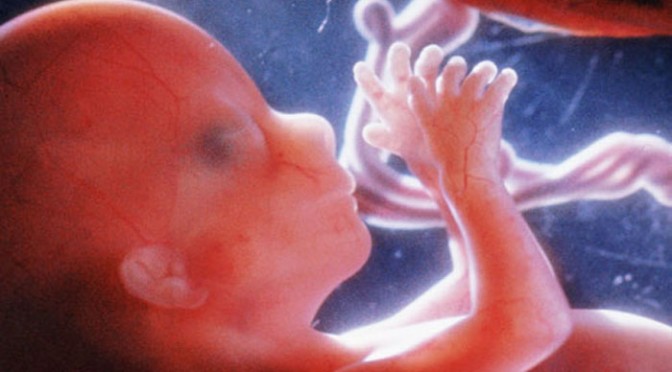There were 7,849 Kansas abortions reported in 2021, an increase of four percent from 2020 (Fig. 1). Chemical abortions increased 5.3 percent from the previous year, making up over two-thirds (68 percent) of all Kansas abortions in 2021. Kansas’ abortion rate rose by four percent to 14 abortions per 1,000 women of childbearing age (Fig. 2). As of January 2023, 27 states have released 2021 abortion statistics, with 19 states showing that abortions had increased from the previous year.
State Report Summary
Fifty percent of Kansas abortions were performed on Kansas residents (including four abortions on Kansas women who traveled out-of-state for their abortions). Fifty percent were performed on women from other states or countries.
Ten percent of Kansas abortions were performed on girls under the age of 20, with three percent of Kansas abortions performed on girls under the age of eighteen. Thirty-two percent were performed on women ages 20 to 24, and 26 percent were on women ages 25 to 29. Twenty-nine percent were obtained by women in their thirties, and three percent were on women ages 40 and older.
Just under half the abortions (48 percent) were performed on non-Hispanic white women. Just over a quarter, 26 percent, were obtained by non-Hispanic black women, and four precent were on Asian or Pacific Islander women. One percent were performed on Native American women, and four percent were on women of other races. The Kansas black abortion rate, 59.2 abortions per 1,000 women ages 15 to 44, was the highest in the nation in 2021 and six times higher than the white abortion rate of 9.4. The high black abortion rate was likely driven by nonresident women who traveled to Kansas for abortions. Kansas has not yet published its tables showing abortions performed on residents versus nonresidents by race in 2021, but in 2020, 65 percent of non-Hispanic black Kansas abortions were performed on nonresidents, compared to 51 percent of non-Hispanic white abortions. Seventeen percent of the abortions were performed on Hispanic women in 2021.
Eighty-five percent of Kansas abortions were performed on unmarried women, compared to 14 percent on married women. One percent were performed on women of unknown marital status. Over two-thirds of the women had been pregnant before: 20 percent of the abortions were performed on women with one prior pregnancy, and 50 percent of the abortions were performed on women with two or more previous pregnancies. Twenty-one percent of the abortions were performed on women with one previous abortion, and 11 percent were on women with more than one. Eighteen percent of the abortions were obtained by women who had previously suffered at least one miscarriage. In contrast, 68 percent of Kansas abortions were performed on women with no previous abortions, 41 percent on women with no living children, 30 percent on women with no previous pregnancies, and 82 percent on women with no prior miscarriages.
Please follow LifeNews.com on Gab for the latest pro-life news and info, free from social media censorship.
In 2021, over two-thirds of Kansas abortions were chemical (68 percent); all but two were induced with mifepristone, while two abortions were induced using methotrexate. Twenty-six percent of the abortions were conducted via suction curettage, and six percent were dilation and evacuation procedures. There were 17 digoxin induction abortions, three sharp curettage abortions, and two hysterectomy abortions.
Seventy percent of Kansas abortions were performed before nine weeks gestation. Just over a fifth (21 percent) occurred between nine and 12 weeks, while six percent were performed between 13 and 16 weeks and four percent between 17 and 21 weeks. Zero abortions were performed at 22 weeks or later. Kansas limits abortion at 20 weeks post-fertilization, approximately 22 weeks gestation. Of the abortions performed in Kansas, ultrasound/sonogram was reported to have been used to determine gestational age in almost 100 percent of the cases. Ultrasound/last menstrual period (LMP) was used in 12 cases, while LMP calculations were used in two cases, and in seven cases, the method of gestational age determination was unknown.
Kansas requires medical professionals to file a report when they encounter a minor who is a victim of abuse or neglect (202 abortions were performed on minors in Kansas in 2021); in 2021, 64 abortion reporting forms indicated that a report of abuse or neglect had been filed.
Nonresident Abortions
Of the nonresident abortions performed in Kansas (3,912 in total), 88 percent were obtained by Missouri residents. Missouri resident abortions increased eight percent from 2020 and nine percent from 2019. Texas residents composed six percent of the nonresident total (three percent of all Kansas abortions), Oklahoma women composed four percent, and Arkansas women composed one percent of the nonresident total.
State Ranking
In 2016, CLI evaluated abortion reporting across 50 states, New York City, and the District of Columbia, and Kansas’ reporting was tied for 15th best. Because chemical abortion use continues to increase in Kansas, the state could require that health care providers report abortion-related complications they treat, since chemical abortion has a higher rate of complications and emergency room visits than does surgical abortion.


- Rates were calculated by CLI using the following formula: (total number of abortions reported by Kansas ÷ number of resident women ages 15 to 44) x 1,000. Rates may differ slightly from previous CLI articles due to revised population estimates. Population estimates were obtained from CDC WONDER. Estimates for 2005-2009 are intercensal estimates of the July 1 resident population. Estimates for 2010-2019 are Vintage 2020 postcensal estimates of the July 1 resident population. Estimates for 2020-2021 are Vintage 2021 postcensal estimates of the July 1 resident population. Estimates were produced by the U.S. Census Bureau and the National Center for Health Statistics.
LifeNews Note: Tessa Longbons writes for the Charlotte Lozier Institute.








